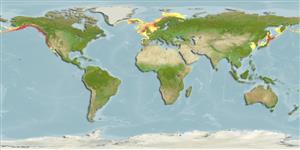Common names from other countries
Environment: milieu / climate zone / depth range / distribution range
Ecologie
; diepteverspreiding 0 - 60 m (Ref. 127878). Temperate
Pacific Ocean. Temperate to polar.
Length at first maturity / Size / Gewicht / Leeftijd
Maturity: Lm ? range ? - ? cm Max length : 32.5 cm TL mannelijk/geslacht niet bekend; (Ref. 865)
Valves: Pure white; completely covered by what appears to be coarse maroon leather. Large white valves (Ref. 296).
Fisheries: The foot of the Gumboot Chiton is sometimes eaten in the same manner as the abalone (Ref. 296). Depth ranges from intertidal to 600 m. Inhabits a variety of bottom-types, but prefer stone and pebble (Ref. 290); at some periods in their life cycle, they teem into the intertidal zone (Ref. 339). Often found on the beach (Ref. 296).
Life cycle and mating behavior
Geslachtsrijpheid | Voortplanting | Kuitschieten | Eieren | Fecundity | Larven
Members of the class Polyplacophora are mostly gonochoric. Life cycle: Eggs hatch into lecitotrophic planktonic trocophore larvae (no veliger stage) which later metamorphose and settle on the bottom as young adults.
Burghardt, G. and L. Burghardt. 2006. (Ref. 296)
Status op de Rode Lijst van het IUCN (Ref. 130435)
Status bij CITES (Ref. 108899)
Not Evaluated
Not Evaluated
Gebruik door de mens
Visserij: van potentieel belang
| FishSource |
Tools
Meer informatie
Leeftijd/GrootteGroeiLengte-gewicht parametersLengte-lengte parametersMorfologieLarvenAbundantie
Internet-bronnen
Estimates based on models
Preferred temperature
(Ref.
115969): 1.5 - 9.9, mean 6 (based on 341 cells).
Kwetsbaarheid
Low vulnerability (20 of 100).
Prijsklasse
Unknown.
